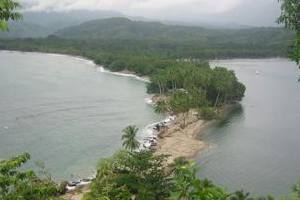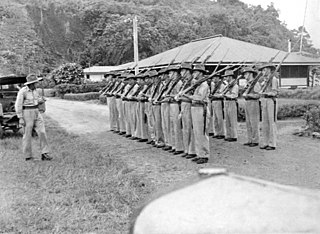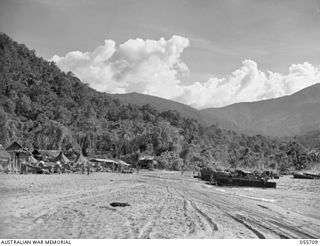
Lae is the capital of Morobe Province and is the second-largest city in Papua New Guinea. It is located near the delta of the Markham River and at the start of the Highlands Highway, which is the main land transport corridor between the Highlands region and the coast. Lae is the largest cargo port of the country and is the industrial hub of Papua New Guinea. The city is known as the Garden City and home of the University of Technology.

Salamaua was a small town situated on the northeastern coastline of Papua New Guinea, in Salamaua Rural LLG, Morobe province. The settlement was built on a minor isthmus between the coast with mountains on the inland side and a headland. The closest city is Lae, which can be reached only via boat across the gulf.

The New Guinea campaign of the Pacific War lasted from January 1942 until the end of the war in August 1945. During the initial phase in early 1942, the Empire of Japan invaded the Australian-administered Mandated Territory of New Guinea and the Australian Territory of Papua and overran western New Guinea, which was a part of the Netherlands East Indies. During the second phase, lasting from late 1942 until the Japanese surrender, the Allies—consisting primarily of Australian forces—cleared the Japanese first from Papua, then the Mandate and finally from the Dutch colony.

Lieutenant General Sir Stanley George Savige, was an Australian Army soldier and officer who served in the First World War and Second World War.

The Battle of Wau, 29 January – 4 February 1943, was a battle in the New Guinea campaign of World War II. Forces of the Empire of Japan sailed from Rabaul and crossed the Solomon Sea and, despite Allied air attacks, successfully reached Lae, where they disembarked. Japanese troops then advanced overland on Wau, an Australian base that potentially threatened the Japanese positions at Salamaua and Lae. A race developed between the Japanese moving overland, hampered by the terrain, and the Australians, moving by air, hampered by the weather. By the time the Japanese reached the Wau area after a trek over the mountains, the Australian defenders had been greatly reinforced by air. In the battle that followed, despite achieving tactical surprise by approaching from an unexpected direction, the Japanese attackers were unable to capture Wau.

The Salamaua–Lae campaign was a series of actions in the New Guinea campaign of World War II. Australian and United States forces sought to capture two major Japanese bases, one in the town of Lae, and another one at Salamaua. The campaign to take the Salamaua and Lae area began after the successful defence of Wau in late January, which was followed up by an Australian advance towards Mubo as the Japanese troops that had attacked Wau withdrew to positions around Mubo. A series of actions followed over the course of several months as the Australian 3rd Division advanced north-east towards Salamaua. After an amphibious landing at Nassau Bay, the Australians were reinforced by a US regimental combat team, which subsequently advanced north up the coast.

The New Guinea Volunteer Rifles (NGVR) was an infantry battalion of the Australian Army. It was initially raised as a unit of the Militia from white Australian and European expatriates in New Guinea upon the outbreak of the Second World War in 1939, before being activated for full-time service following the Japanese landings in early 1942. NGVR personnel then helped rescue survivors of Lark Force from Rabaul in February and March 1942. Between March and May, the NGVR monitored the Japanese bases which had been established in the Huon Gulf region, being the only Allied force in the area until the arrival of Kanga Force at Wau in May. The battalion subsequently established observation posts overlooking the main approaches and reported on Japanese movements.

The 2/5th Commando Squadron was one of twelve independent companies and or commando squadrons of the Australian Army formed for service during World War II. Initially formed in 1942 as the "2/5th Independent Company", the 2/5th served in New Guinea, taking part in a major commando raid on Salamaua in June 1942. It was later withdrawn from New Guinea and reformed as the "2/5th Cavalry (Commando) Squadron", as part of the 2/7th Cavalry (Commando) Regiment which saw service in Borneo in 1945. It was disbanded in early 1946.

Kanga Force was the name given to a composite ad hoc formation of the Australian Army that served in New Guinea during World War II. Commanded by Major Norman Fleay, it was formed on 23 April 1942. Made up of elements from the 1st and 2/5th Independent Companies and the New Guinea Volunteer Rifles (NGVR), Kanga Force conducted a number of small scale raids and reconnaissance operations around Lae and Salamaua before it was disbanded and the individual units became part of the Australian 3rd Division in 1943.

The Landing at Nassau Bay was an amphibious landing by Allied forces at Nassau Bay during the New Guinea campaign of World War II that took place between 30 June and 6 July 1943. The operation was undertaken so that Allies could secure a beachhead to establish a supply point to shorten their supply lines for the proposed attack on Salamaua as part of the Salamaua–Lae campaign and resulted in a battalion-sized force of US infantry and supporting elements being landed largely unopposed on the south-eastern flank of the battle zone.

New Guinea Force was a military command unit for Australian, United States and native troops from the Territories of Papua and New Guinea serving in the New Guinea campaign during World War II. Formed in April 1942, when the Australian First Army was formed from the Australian I Corps after it returned from the Middle East, it was responsible for planning and directing all operations within the territory up until October 1944. General Headquarters Southwest Pacific Area Operational Instruction No.7 of 25 May 1942, issued by Commander-Allied-Forces, General Douglas MacArthur, placed all Australian and US Army, Air Force and Navy Forces in the Port Moresby Area under the control of New Guinea Force. Over the course of its existence, New Guinea Force was commanded by some of the Australian Army's most notable commanders, including Sydney Rowell, Sir Edmund Herring and Sir Leslie Morshead.

The Landing at Nadzab was an airborne landing on 5 September 1943 during the New Guinea campaign of World War II in conjunction with the landing at Lae. The Nadzab action began with a parachute drop at Lae Nadzab Airport, combined with an overland force.

The Invasion of Salamaua–Lae, called Operation SR by the Japanese, was an operation by Imperial Japanese forces to occupy the Salamaua–Lae area in the Territory of New Guinea during the Pacific campaign of World War II. The Japanese invaded and occupied the location in order to construct an airfield and establish a base to cover and support the advance of Japanese forces into the eastern New Guinea and Coral Sea areas. The small Australian garrison in the area withdrew as the Japanese landed and did not contest the invasion.
Phillip Bradley is an Australian military historian who has written five books as well as numerous articles for Wartime and After the Battle magazine. He has been described as "One of the finest chroniclers of the Australian Army's role in the New Guinea campaign".

The Battle of the Pimple was part of the Markham and Ramu Valley – Finisterre Range campaign, which consisted of a number of battles fought by Australian and Japanese troops in Papua New Guinea in World War II. Fought on 27 and 28 December 1943, the battle took place as the Australians advanced towards the Japanese strong hold around Shaggy Ridge, and was a preliminary phase in their eventual capture of that position in January 1944. Supported by artillery, mortars, machine guns and fighter-bomber aircraft, the assault was made across a narrow frontage, which was usually not much wider than a single section. Two companies of Australian infantry were committed to the attack, with one securing the initial crest, while the other exploited the position and secured several other smaller features throughout the two days of fighting. In the aftermath, Japanese artillery harassed the Australians holding the position, and subjected them to several counter-attacks, which were eventually defeated.
The Battle of Lababia Ridge was fought from 20–23 June 1943 in the Territory of New Guinea during World War II. Part of the Salamaua–Lae campaign, the battle involved Australian and Japanese troops who clashed on the ridge, which was about 20 kilometres (12 mi) south of Salamaua, near Mubo, over the course of several days. The battle was fought in conjunction with several other actions in the region as the Allies attempted to draw Japanese attention away from Lae, where they launched seaborne landings in mid-September 1943, in conjunction with airborne landings around Nadzab. The fighting around Lababia Ridge took place at the same time as the Battle of Mubo, after two battalions of Japanese infantry launched a counter-attack on a depleted Australian company. The Australians, supported by Royal Australian Air Force fighter-bombers, managed to hold off the initial Japanese attacks before being reinforced by another depleted company. Fighting continued over the course of three days before the Japanese withdrew.

The Battle of Mubo was a series of actions in the Mubo area of the Territory of New Guinea between Australian and Japanese forces which took place between 22 April and 14 July 1943, during World War II. The battle formed part of the wider Salamaua–Lae campaign, and was fought in the early stages of the campaign. The battle followed the successful defence of the airfield around Wau by the Australians in late January 1943, after the Japanese had attempted to infiltrate the Australian positions with two infantry battalions.

The Battle of Bobdubi was a series of actions fought in the Salamaua area of the Territory of New Guinea between Australian and Japanese forces which took place from 22 April to 19 August 1943, during World War II. Part of the Allied advance on Salamaua, the battle was fought in conjunction with several other actions in the region as the Allies attempted to draw Japanese attention away from Lae, where they launched seaborne landings in mid-September 1943 in conjunction with airborne landings around Nadzab. The initial phase of the fighting around Bobdubi was characterised mainly by small unit harassment and reconnaissance operations, while the second phase saw the capture of a number of Japanese defensive positions in locations dubbed "Old Vickers", "Timbered Knoll" and the "Coconuts".

The Battle of Roosevelt Ridge was fought between 21 July and 14 August 1943 between US and Japanese forces in the Salamaua area of the Territory of New Guinea during World War II. The battle was fought in conjunction with several other actions of the Salamaua–Lae campaign. Throughout the first half of 1943, Australian forces had clashed with the Japanese around Wau and then Mubo as they had pushed the Japanese back towards Salamaua. As the campaign had developed, the Japanese had brought in reinforcements from elsewhere in New Guinea, effectively reducing their garrison, particularly around Lae. Following fighting on Lababia Ridge, the Australians had begun securing positions around Bobdubi, with a view to extending towards Mount Tambu.

The Battle of Mount Tambu was a series of actions fought in the Salamaua area of the Territory of New Guinea between Allied and Japanese forces, which took place between 16 July and 18 August 1943, during World War II. The battle formed part of the wider Salamaua–Lae campaign and was fought in the final stages of the campaign, which had seen a combined Australian and US force advance from Wau towards Salamaua following the repulse of the Japanese attack on Wau in late January and early February 1943. After several frontal assaults on the position by Australian and US infantrymen were rebuffed by determined Japanese defenders, an indirect approach was sought and flanking moves were undertaken to cut off the Japanese supply route along the Komiatum Track. This succeeded in eventually forcing the Japanese off the position as they withdrew to avoid encirclement.